|
Week 10: October 3 - 9, 2012 |
Welcome
to the McGill Bird Observatory weekly report.
Click here for a complete listing of our archives.
Comments or
questions are welcome at "mbo AT migrationresearch.org".
|
PICTURE
OF THE WEEK: |
|
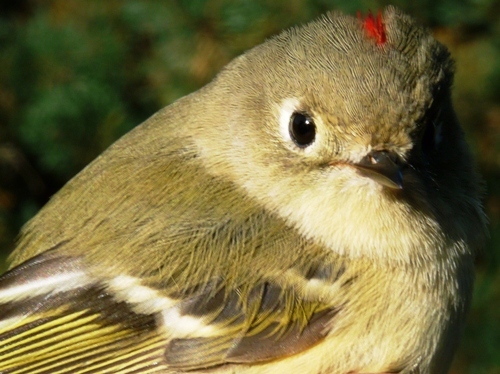
In a week as busy as this, there were many highlights, but the bird of the week was
this after-hatch-year male Ruby-crowned Kinglet, for the simple reason that on Sunday
morning
it became the
40,000th bird banded at MBO since our start in 2004.
(Photo by Marcel Gahbauer)
-
|
|
|
THIS WEEK |
THIS FALL |
2012 TOTAL |
SITE TOTAL |
|
# birds (and species) banded |
850 (36) |
3264 (80) |
4529 (87) |
40280 (108) |
|
# birds (and species) repeat |
152 (17) |
800 (48) |
1138 (59) |
7551 (70) |
|
# birds (and species) return |
3 (1) |
69 (20) |
208 (27) |
1169 (38) |
|
# species observed |
78 |
140 |
165 |
207 |
|
# net hours |
477.5 |
5351.3 |
8611.1 |
67710.2 |
|
# birds banded / 100 net hours |
178.0 |
61.0 |
52.6 |
59.5 |
|
|
Note: table does not include nocturnal banding (owls) |
|
Banders-in-charge: Bob Barnhurst, Simon Duval, Marcel Gahbauer, Gay Gruner
Assistants: Nicolas Bernier, Cindy Bouchard, Chantal Cloutier, David Davey, Rui de Jesus, Jean Demers, Leah den Besten, Amanda Droghini, Steve Dumont, Réjean Duval, Barbara Frei, Louise Gagné, Monique Groulx, Alison Hackney, Marie-Anne Hudson, James Junda, Lisa Keelty, Shelley Kirk, Marie-Pier Laplante, Lance Laviolette, Meghan Laviolette, Andrée-Anne Laviolette, Barbara MacDuff, Betsy McFarlane, Ana Morales, Benoit Piquette, Geneviève Potvin, Lisa Rosenberger, Marilou Skelling, Clémence Soulard, Alex Stone, Rodger Titman, Carine Touma, Yifu Wang
Notes: This week was without a doubt the peak of migration for 2012! After a relatively modest movement of migrants last week, we had a strong increase in numbers this week, with our fifth-highest ever weekly total of birds banded, and nearly twice as many as last week, which was our busiest to date this fall. Unlike the four previous weeks with higher counts, all of which were driven overwhelmingly by an explosion of Yellow-rumped Warblers, this week's bounty was almost evenly shared between them, Ruby-crowned Kinglets, and White-throated Sparrows, as well as a rich supporting cast. For example, Thursday's count of 241 birds banded was not only our busiest day of the fall (and fourth highest ever, behind only three crazy days between September 23 and 27, 2010), but the 27 species banded that day was also the highest diversity we've had in a single day this season. Thankfully we had a full complement of great volunteers this week, not only keeping the extraction and banding processes moving along efficiently, but also still finding time to observe the other species on site. We ranged between 43 and 55 species observed daily, which is unusually high for MBO in October. Even on Saturday, when we lost the first three hours of the morning to heavy rain, we managed to observe 33 species on census and ended up with a daily estimated total of 43 species.
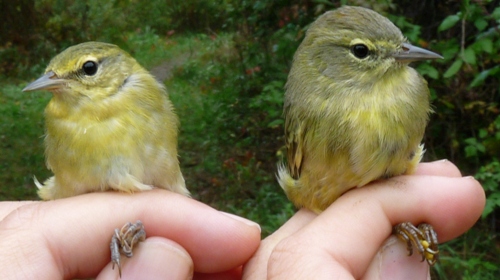
For the second week in a row, we have a comparison of two greenish-gray warblers in this space. This time though, the one on the left is a Tennessee Warbler (with a stronger facial pattern), and the one on the right is an Orange-crowned Warbler (with a trace of streaking on the breast). Below is another particularly yellow Orange-crowned Warbler we banded this week, looking much like the western orestera subspecies.
(Photos by
Marcel Gahbauer)
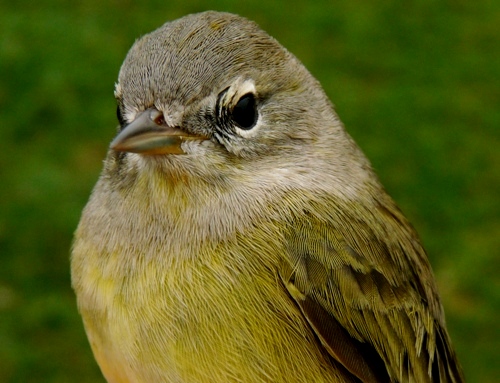
|
Heading into the final month of the season, it is becoming more difficult to add new species to our list for either fall or the year. This week the only new sighting for 2012 was Field Sparrow, while we also had our first Fox Sparrows of fall. After the count period ended on Sunday, we saw a Cackling Goose flying overhead with a flock of much larger Canada Geese, but we will have to wait for another one to show up within our standard hours for it to count for the season. Earlier in the week, we also had a sighting of a mystery warbler that best matched the description of Prairie Warbler, but unfortunately it did not hang around long enough for us to confirm its identity. We banded our first Winter Wren and Fox Sparrow of fall, the wren actually being the first of the year.
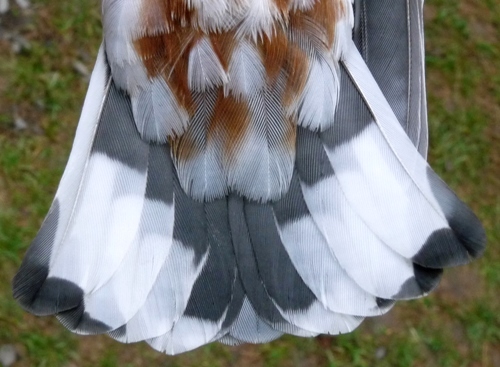
Quiz - to what species does this undertail belong?
(Photo by
Marcel Gahbauer)
-
|
This week’s top 10 [last week's rank in brackets]
# individuals banded |
mean # individuals observed daily |
1. Yellow-rumped Warbler (170) [2] |
1. Common Grackle (525) [4] |
2. Ruby-crowned Kinglet (165) [3] |
2. Canada Goose (407) [1] |
3. White-throated Sparrow (158) [1] |
3. Red-winged Blackbird (270) [2] |
4. Slate-colored Junco (80) [-] |
4. European Starling (251) [3] |
5. Hermit Thrush (38) [-] |
5. White-throated Sparrow (141) [5] |
6. White-crowned Sparrow (35) [10] |
6. American Robin (137) [6] |
7. Golden-crowned Kinglet (21) [6] |
7. Slate-colored Junco (73) [-] |
8. American Robin (19) [-] |
8. Yellow-rumped Warbler (69) [8] |
8. Song Sparrow (19) [5] |
9. American Crow (59) [9] |
8. Common Grackle (19) [-]
|
10. Ruby-crowned Kinglet (55) [-] |
|
It was a tight three-way race this week among the most frequently banded birds. Except for 2005 and 2007, the top three species banded in week 10 have always been Ruby-crowned Kinglet, Yellow-rumped Warbler, and White-throated Sparrow, although the relative abundance of these species has varied over the years. In the last two "even years", Yellow-rumped Warblers absolutely dominated week 10; this year they still came out on top, but only barely - and largely thanks to two good days (80 banded on Thursday and another 56 on Friday). In contrast, both of the other species were steady throughout the week, with at least a dozen of each banded daily except on our rain-shortened Saturday. Not surprisingly after a week like this, these three species are now also in the lead for the season, with White-throated Sparrow well out in front with 421 individuals banded, at this pace just one day away from a new fall record. In fourth place, well back of the top three, was Slate-colored Junco - but the 80 individuals banded this week is still noteworthy as it's by far the largest number we've ever had so early in fall (the previous best for week 10 was just 44 juncos, back in 2007. That year the junco migration petered out early, whereas in our "big" junco years, they have tended to peak later in October, so we are curious to see what develops over the rest of this month. Also easily overlooked in a week like this is that the 38 Hermit Thrushes banded is the second-highest single-week count for these species, just five short of the week 11 count in 2010. White-crowned Sparrows had a good week too, with more than twice as many banded this week as in all of last fall. Golden-crowned Kinglets also seem on the way to an above-average season, with another 21 banded this week, and a season total to date of 49. Rounding out the top ten was a three-way tie with 19 individuals each - the first wave of American Robins, a relatively late push of Song Sparrows, and a fraction of the giant flock of Common Grackles that got caught flying a bit low through the cottonwood grove. Swainson's Thrush finally dropped out of the top ten this week, but just barely, with another 18 banded, bringing the season total to a remarkable 174. Also displaced from the top ten this week were Blue Jay, Black-capped Chickadee, and Nashville Warbler.
The list of top species observed shows just how busy MBO was this week - just these ten species alone add up to a daily mean of nearly 2000 birds, roughly half of which was accounted for by the giant mixed flocks of European Starlings, Red-winged Blackbirds, and Common Grackles. Canada Goose was the only other species that managed to crack the top four, with daily counts ranging from 75 to nearly 1000, but this is the first time in eight years that it was not the top species in week 10. Although only in fifth place behind the giant flocks of the top four, White-throated Sparrows were impressively abundant throughout the week, with as many as 168 along the census trail, and no fewer than 86 on site any day; even though week 10 is traditionally the peak for this species, the numbers this week were roughly double the long-term average for this time of year. Only barely behind in sixth place was American Robin, with flocks building from a few dozen per day early in the week to a couple of hundred per day toward the end of the week, reflecting the onset of the traditional mid-October influx. Three of the remaining four places in the top ten species observed were occupied by species that dominated the nets this week: Yellow-rumped Warbler, Ruby-crowned Kinglet, and Slate-colored Junco; the lone other interloper was American Crow. The only two species that dropped out from last week's top ten were Blue Jay and Black-capped Chickadee, and both were still quite common this week, but just couldn't match the 50+ per day threshold set by the other species.
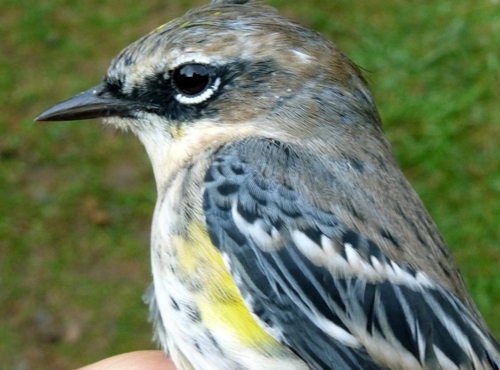
Among the many Yellow-rumped Warblers banded this week were the after-hatch-year male above with an unusually dark face, as well as the after-hatch-year female below in an unusually early stage of moult, with four secondaries still retained, and the outer primaries not yet fully replaced.
(Photos by
Marcel Gahbauer)
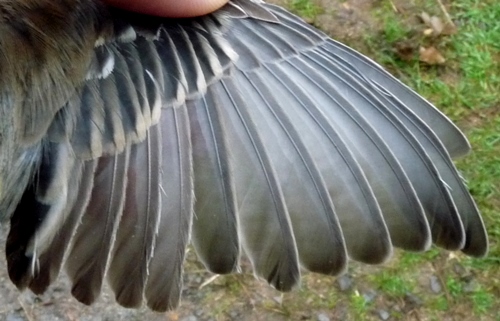 |
Our second week of Northern Saw-whet Owl migration monitoring was overall very similar to the first, with another 42 Northern Saw-whet Owls banded, bringing our total to 83. Also in the mix this week was our first foreign recapture of the season, a fourth-year bird that was banded at King's Gap, Pennsylvania, in October 2010. Weather allowed us to go out every night this week, but we were shut out on October 5 and the bulk of owls came later in the week, with 13 on the night of the 7th, and another 17 (plus the foreign recap) on the night of the 8th.
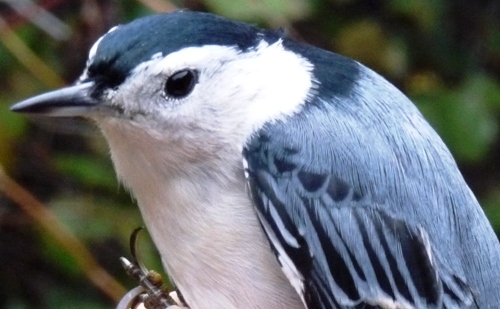
Quiz answer - the undertail belongs to this White-breasted Nuthatch, just the tenth of its kind banded at MBO (but the fourth this fall). Meanwhile, below is another Ruby-crowned Kinglet with aberrant plumage - last week we had one with an entirely golden crown patch; this week the one below had a mix of red and yellow.
(Photos by
Marcel Gahbauer)
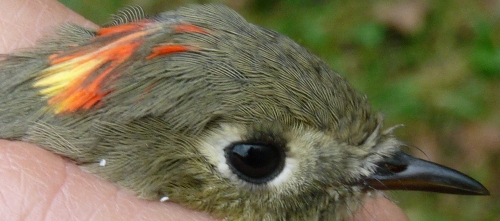
|
After ten weeks, there are ten species that we have banded in each week this fall: Red-eyed Vireo, Black-capped Chickadee, Swainson's Thrush, Gray Catbird, Nashville Warbler, Tennessee Warbler, Common Yellowthroat, Magnolia Warbler, Song Sparrow, and White-throated Sparrow. Chances are that week 10 will end up being the end of the streak for some of these species, but at least a few of them are likely to stay with us for the remainder of fall.
With three weeks remaining in this year's Fall Migration Monitoring Program, we have already banded more birds than in four of the previous seven full fall seasons. Many more kinglets, robins, juncos, and other sparrows are still expected to come, so chances are good that we will end the season with over 4000 birds banded. However, we have had plenty of surprises already this fall, and would be foolish to make too many predictions about how the remainder of October will unfold.
|
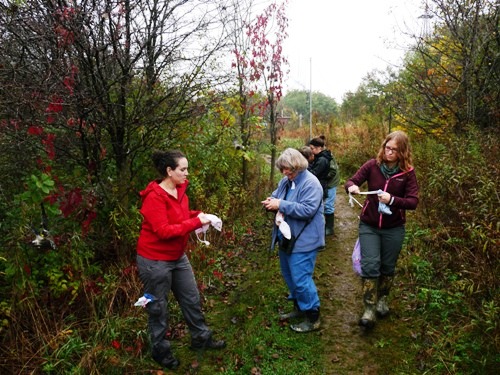
We always appreciate the contributions of all our volunteers, but the value of an experienced and diverse team is all the more apparent at the peak of migration. Especially given that this week also included Thanksgiving, we would like to take this opportunity to extend our appreciation to everyone who has helped at MBO this year in any capacity. Above, part of our Thursday morning crew efficiently working their way through clearing a busy net H1.
(Photo by Marcel Gahbauer)

Meanwhile on the same day, "Team Duval" (bander Simon and scribe Réjean, no relation) were busy inside keeping up with all the birds being brought in from the nets.
(Photo by Marcel Gahbauer)
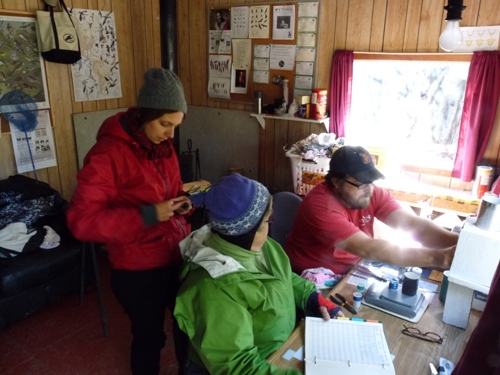
One of the reasons for MBO's success is our focus on training and welcoming banders from elsewhere, which helps ensure that we have the capacity to handle peak periods safely. On one of this week's busier days, the bander-in-charge was able to take a breather, knowing that James Junda (our bander from fall 2008, now back in Montreal to pursue his M.Sc.) and Marie-Pier Laplante (one of our banders-in-training) could efficiently process the birds, with Alison Hackney ably juggling data entry for both.
(Photo by
Marcel Gahbauer)
|











